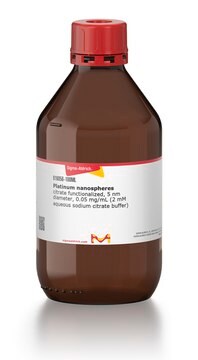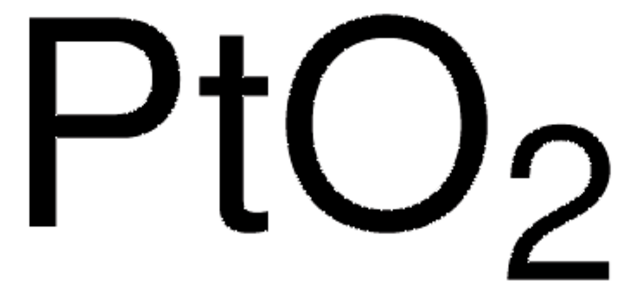Key Documents
685453
Platinum
nanopowder, <50 nm particle size (TEM)
Synonim(y):
Platinum black, Platinum element
About This Item
Polecane produkty
Postać
nanopowder
przydatność reakcji
reagent type: catalyst
core: platinum
rezystywność
10.6 μΩ-cm, 20°C
wielkość cząstki
<50 nm (TEM)
tw
3827 °C (lit.)
mp
1772 °C (lit.)
gęstość
21.45 g/cm3 (lit.)
ciąg SMILES
[Pt]
InChI
1S/Pt
Klucz InChI
BASFCYQUMIYNBI-UHFFFAOYSA-N
Opis ogólny
Zastosowanie
- Main Group SnN(4)O Single Sites with Optimized Charge Distribution for Boosting the Oxygen Reduction Reaction.: This research focuses on the application of SnN(4)O single sites, enhanced by platinum, to improve the oxygen reduction reaction, a crucial process in fuel cells and metal-air batteries. The study highlights the potential of these materials in creating more efficient and durable energy storage solutions. (Shao et al., 2024).
- Hydrogen spillover inspired bifunctional Platinum/Rhodium Oxide-Nitrogen-Doped carbon composite for enhanced hydrogen evolution and oxidation reactions in base.: This paper discusses a composite material using platinum and rhodium oxide, designed to enhance hydrogen evolution and oxidation reactions. This advancement is significant for renewable energy storage and hydrogen fuel cell technologies. (Kumar Manna et al., 2024).
- Rapid synthesis of high-purity molybdenum carbide with controlled crystal phases.: Although primarily focused on molybdenum carbide, this study provides insights into high-purity synthesis techniques that could be applicable to platinum-based materials, potentially benefiting academic research and industrial applications. (Fang et al., 2024).
- Solar-assisted selective separation and recovery of precious group metals from deactivated air purification catalysts.: This research explores a method for recovering platinum group metals from used catalysts using solar energy. This method could be beneficial for sustainable industrial practices and the recycling of high-value materials. (Wu et al., 2024).
Informacje prawne
Hasło ostrzegawcze
Danger
Zwroty wskazujące rodzaj zagrożenia
Zwroty wskazujące środki ostrożności
Klasyfikacja zagrożeń
Flam. Sol. 1
Kod klasy składowania
4.1B - Flammable solid hazardous materials
Klasa zagrożenia wodnego (WGK)
nwg
Temperatura zapłonu (°F)
Not applicable
Temperatura zapłonu (°C)
Not applicable
Środki ochrony indywidualnej
Eyeshields, Gloves, type P3 (EN 143) respirator cartridges
Wybierz jedną z najnowszych wersji:
Masz już ten produkt?
Dokumenty związane z niedawno zakupionymi produktami zostały zamieszczone w Bibliotece dokumentów.
Klienci oglądali również te produkty
Produkty
Professor Ebrahimi and Professor Robinson (Pennsylvania State University, USA) summarize recent advances in the synthesis of these 2D materials, resulting material properties, and related applications in biosensing of neurotransmitters, metabolites, proteins, nucleic acids, bacterial cells, and heavy metals.
Since the demonstration of the first practical solar cell 60 years ago, research on novel materials, improved solar cell design and structure, and innovative manufacturing processes have all contributed to a continuous increase in the efficiency of photovoltaic (PV) devices.
Graphene is a unique two-dimensional (2D) structure of monolayer carbon atoms packed into a dense honeycomb crystal that has attracted great interest due to its diverse and fascinating properties.
Electronically, it behaves as a wide band gap (3.2 eV) semiconductor and exhibits memristor properties.2 Optically, TiO2 has high opacity with a very high refractive index3 (>2.4), and it exhibits strong absorbance in the UV range.
Nasz zespół naukowców ma doświadczenie we wszystkich obszarach badań, w tym w naukach przyrodniczych, materiałoznawstwie, syntezie chemicznej, chromatografii, analityce i wielu innych dziedzinach.
Skontaktuj się z zespołem ds. pomocy technicznej







![Poly[2-methoxy-5-(2-ethylhexyloxy)-1,4-phenylenevinylene] average Mn 40,000-70,000](/deepweb/assets/sigmaaldrich/product/structures/344/488/b8f8179d-3970-4deb-a754-adda88cdb36f/640/b8f8179d-3970-4deb-a754-adda88cdb36f.png)
